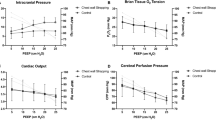Abstract
Background
A standardized large animal model for controlled ICP manipulation within a relevant range and repetitive ICP measurements is missing. We sought to develop such a model on the base of controlled IPP changes induced by capnoperitoneum.
Methods
We utilized six female pigs (mean body weight 59.5 ± 18.4 kg) for experiments. A ventricular catheter connected with a burr hole reservoir was implanted. ICP was measured directly as cm H2O within a riser tube after percutaneous cannulation of the reservoir. A noninvasive intraperitoneal pressure (IPP) measurement was established (intravesical). Animals were placed in lateral position and a capnoperitoneum was induced. Measurements of ICP, IPP, MAP and respiratory parameters were performed at baseline IPP and after CO2 insufflation to IPP levels of 20 and 30 mmHg.
Results
Baseline IPP in lateral position referenced to median line was 9.8 (±2) mm Hg, while corresponding ICP was 10 (±2.2) mm Hg. After IPP elevation to 20 mmHg, ICP increased to 18.8 (±1.9) mm Hg. At 30 mmHg IPP, ICP increased to 22.8 (±2.8) mm Hg. Except peak airway pressure, all other parameters were kept constantly. Mean ICP variation in the individual subject was 13.4 (±2.5) mm Hg, while a ICP range from minimum 9 to maximum 31 mmHg was documented.
Conclusions
We report a large animal model that allows (1) repeated measurement of the ICP and (2) manipulation of the ICP within a large pressure range by controlled IPP changes due to capnoperitoneum.

Similar content being viewed by others
References
Al-Tamimi YZ, Helmy A, Bavetta S, Price SJ (2009) Assessment of zero drift in the Codman intracranial pressure monitor: a study from 2 neurointensive care units. Neurosurgery 64(1):94–98, discussion 98–99
Bloomfield GL, Ridings PC, Blocher CR, Marmarou A, Sugerman HJ (1996) Effects of increased intra-abdominal pressure upon intracranial and cerebral perfusion pressure before and after volume expansion. J Trauma 40(6):936–941, discussion 941–943
Bloomfield GL, Ridings PC, Blocher CR, Marmarou A, Sugerman HJ (1997) A proposed relationship between increased intra-abdominal, intrathoracic, and intracranial pressure. Crit Care Med 25(3):496–503
Doyle DJ, Mark PW (1992) Analysis of intracranial pressure. J Clin Monit 8(1):81–90
Gaab MR, Heissler HE (1984) ICP monitoring. Crit Rev Biomed Eng 11(3):189–250
Ginggen A, Tardy Y, Crivelli R, Bork T, Renaud P (2008) A telemetric pressure sensor system for biomedical applications. IEEE Trans Biomed Eng 55(4):1374–1381
Gudmundsson FF, Viste A, Gislason H, Svanes K (2002) Comparison of different methods for measuring intra-abdominal pressure. Intensive Care Med 28(4):509–514
Halverson A, Buchanan R, Jacobs L, Shayani V, Hunt T, Riedel C, Sackier J (1998) Evaluation of mechanism of increased intracranial pressure with insufflation. Surg Endosc 12(3):266–269
Heppner F, Lanner G, Rodler H (1976) Telemetry of intracranial pressure. Acta Neurochir (Wien) 33(1–2):37–43
Van Hulst RA, Hasan D, Lachmann B (2002) Intracranial pressure, brain PCO2, PO2, and pH during hypo- and hyperventilation at constant mean airway pressure in pigs. Intensive Care Med 28(1):68–73
Josephs LG, Este-McDonald JR, Birkett DH, Hirsch EF (1994) Diagnostic laparoscopy increases intracranial pressure. J Trauma 36(6):815–818, discussion 818–819
Kaiser GM, Frühauf NR (2007) Method of intracranial pressure monitoring and cerebrospinal fluid sampling in swine. Lab Anim 41(1):80–85
Kasotakis G, Michailidou M, Bramos A, Chang Y, Velmahos G, Alam H, King D, De Moya MA (2012) Intraparenchymal vs extracranial ventricular drain intracranial pressure monitors in traumatic brain injury: less is more? J Am Coll Surg 214(6):950–957
Kiefer M, Antes S, Leonhardt S, Schmitt M, Orakcioglu B, Sakowitz OW, Eymann R (2012) Telemetric ICP measurement with the first CE-approved device: data from animal experiments and initial clinical experiences. Acta Neurochir Suppl 114:111–116
Lescot T, Reina V, Le Manach Y, Boroli F, Chauvet D, Boch A-L, Puybasset L (2011) In vivo accuracy of two intraparenchymal intracranial pressure monitors. Intensive Care Med 37(5):875–879
Miyake H, Ohta T, Kajimoto Y, Matsukawa M (1997) A new ventriculoperitoneal shunt with a telemetric intracranial pressure sensor: clinical experience in 94 patients with hydrocephalus. Neurosurgery 40(5):931–935
Morgalla MH, Mettenleiter H, Bitzer M, Fretschner R, Grote EH (1999) ICP measurement control: laboratory test of 7 types of intracranial pressure transducers. J Med Eng Technol 23(4):144–151
Orakcioglu B, Beynon C, Kentar MM, Eymann R, Kiefer M, Sakowitz OW (2012) Intracranial pressure telemetry: first experience of an experimental in vivo study using a new device. Acta Neurochir Suppl 114:105–110
Raboel PH, Bartek J Jr, Andresen M, Bellander BM, Romner B (2012) Intracranial pressure monitoring: invasive versus non-invasive methods-a review. Crit Care Res Pract 2012:950393
Richard KE, Block FR, Weiser RR (1999) First clinical results with a telemetric shunt-integrated ICP-sensor. Neurol Res 21(1):117–120
Rosenthal RJ, Hiatt JR, Phillips EH, Hewitt W, Demetriou AA, Grode M (1997) Intracranial pressure. Effects of pneumoperitoneum in a large-animal model. Surg Endosc 11(4):376–380
Schaller WF (1933) The propriety of diagnostic lumbar puncture in intracranial hypertension. J Neurol Psychopathol 14(54):116–123
Schödel P, Proescholdt M, Ullrich O-W, Brawanski A, Schebesch K-M (2012) An outcome analysis of two different procedures of burr-hole trephine and external ventricular drainage in acute hydrocephalus. J Clin Neurosci 19(2):267–270
Stehlin E, Malpas S, Heppner P, Hu P, Lim M, Budgett D (2012) Implantable ICP monitor for improved hydrocephalus management. Acta Neurochir Suppl 114:101–104
The Brain Trauma Foundation. The American Association of Neurological Surgeons. The Joint Section on Neurotrauma and Critical Care (2000) Indications for intracranial pressure monitoring. J Neurotrauma 17(6–7):479–491
Wiegand C, Richards P (2007) Measurement of intracranial pressure in children: a critical review of current methods. Dev Med Child Neurol 49(12):935–941
Wurst H, Schulte-Steinberg H, Finsterer U (1993) Pulmonary CO2 elimination in laparoscopic cholecystectomy. A clinical study. Anaesthesist 42(7):427–434
Zhong J, Dujovny M, Park HK, Perez E, Perlin AR, Diaz FG (2003) Advances in ICP monitoring techniques. Neurol Res 25(4):339–350
Conflicts of interest
None.
Author information
Authors and Affiliations
Corresponding author
Rights and permissions
About this article
Cite this article
Freimann, F.B., Chopra, S.S., Unger, J.K. et al. Evaluation of a new large animal model for controlled intracranial pressure changes induced by capnoperitoneum. Acta Neurochir 155, 1345–1349 (2013). https://doi.org/10.1007/s00701-013-1696-y
Received:
Accepted:
Published:
Issue Date:
DOI: https://doi.org/10.1007/s00701-013-1696-y




